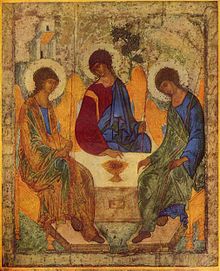Trinity icon
The icon of the Trinity ( Russian троица , scientific transliteration troica ) by Andrei Rublev is considered to be one of the highlights of Russian painting . The same motif can be found on countless other icons throughout the Orthodox field.
history
The painting, created around 1411, is 142 cm × 114 cm in size. The masterpiece of icon painting is also a theology in color. Rublev's representation of the Trinity was described by a Moscow synod in 1551 as dogmatic exemplary and binding.
Today the icon is exhibited in the Tretyakov Gallery in Moscow .
interpretation
The picture does not represent the Trinity directly, because direct pictorial representations of God the Father are unusual in Orthodoxy (since there is no incarnated image of God the Father handed down in the Bible ). Rather, it symbolizes it by means of a scene from the Old Testament : the visit of the three angel messengers to Abraham and Sarah ( Gen 18.1–33 EU ) in the grove of Mamre and interprets this visit as the appearance of the Trinity. The three angels are seated around a table with a goblet on it. Each of the three persons holds a staff, the symbol of authority, after which all three have the same divine authority. An older tradition of the motif also shows Abraham and Sarah serving the three angels.
The table is the symbol for the altar , the chalice is the symbol for the divine sacrificial lamb of the Eucharist and each of the three persons shows their relationship to him with a wave of the hand. The three figures are very similar, but not the same; however, no differences in rank or age can be seen.
The assignment of the three figures to the three persons of the Trinity is controversial. Some argue that the father is represented by the figure in the middle; he points with two fingers to the chalice to indicate the divine and human nature of the sacrificial lamb. The son, on the left, seen from the viewer (the son is sitting on the right of the father), has raised his hand in a gesture of blessing, showing that he is accepting the mission that is destined for him. The Holy Spirit, to the right of the Son, points to a rectangular opening in the table that symbolizes the world, indicating that the Son is being sent into the world and for the salvation of the world.
Others argue that the figure in the middle is the son. The father is sitting on the left in the picture, the other two figures are leaning towards him. This view is more convincing for the following reasons: 1. Rublev's followers soon clearly labeled the figure in the center as Christ. 2. If the figure in the middle wears the clothes that Christ always wears, namely red undergarment and green or blue overgarment, and 3. Christ makes the most sense as the content of the cup mentioned in the next section.
The two figures on the left and right, together with their silhouettes, form a goblet that surrounds the figure in the middle. At the same time a cross is shown, formed from the three heads horizontally - and vertically from the middle figure, the chalice on the table and the world.
The “wrong” perspective (the vanishing point is in front of the picture) includes the viewer, lets him participate in the sacred events.
Color symbolism
Rublev used various shades of gold and blue in the color palette. Blue and gold are the colors of the visualization of transcendence even in early Christian times. On Rublev's Trinity icon, part of the robe of each of the three angels depicted is blue, the wings golden yellow and the halo light yellow. The angel in the middle wears a purple robe with a blue cloak, which is thereby particularly emphasized. The angel on the left wears a gold-shimmering, transparent cloak over the blue robe, the angel on the right wears a green cloak over the blue robe. The color symbolism of the picture assigns the blue-red to the Creator God in the middle, the light-gold-blue to Christ and the green-blue to the Holy Spirit. The contrast of red and blue, with its original meaning of activity and rest, life and death, protection and threat, is here combined into a unity and symbolizes the omnipotence of God.
Individual evidence
-
↑ Icons, masterpieces of the Eastern Church (= Bildlexikon der Kunst, Volume 9). Parthas Verlag, Berlin, 2005, p. 70
CD-Rom Icons of the Orthodox Church, ISBN 3-936122-21-0 of the digital library - ↑ A. Tradigo: Icons and Saints of the Eastern Orthodox Church . Los Angeles 2006, p. 68
- ↑ K. Onasch, A. Schnieper: Icons . Munich 2007, p. 142; 144
- ↑ see the links from Müller and Löwenstein given below
- ↑ cf. z. B. the images on http://www.icon-art.info/topic.php?lng=de&top_id=2
- ↑ Riklef Kandeler 2003: Symbolism of Plants and Colors: Botanical Art and Cultural History in Examples . Publishing house of the Zoological-Botanical Society in Austria, 2003. ISBN 3-901294-07-4 . Pp. 121-122
Web links
- Interpretation of the icon by Ludolf Müller ( Quatember 1982)
- Interpretation of the icon by Jesuit Father Martin Löwenstein SJ
- www.icon-art.info
